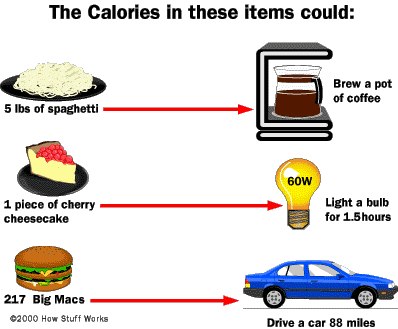“That has so many calories!” “How many calories are in that?” The real question that everyone wants to know is, “what is a calorie?”
A calorie is nothing more than a unit that we use to measure energy. A calorie can be defined as the amount of energy or heat it takes to raise the temperature of one gram of water one degrees Celsius, or 1.8 degrees Fahrenheit.
Now, when it comes to food, 1,000 calories are actually one kilocalorie. For example, if a can of soda is 150 calories, it has 150,000 regular calories, or 150 kilocalories. So, when we say calories we are really talking about kilocalories.
As humans we need fuel, or energy to live. The way that we get this energy is through food. Think about it this way, our bodies “burn” calories. Everything you eat has three macro nutrients, or building blocks that humans use as an energy source, carbohydrates, protein, and fats. Each gram of carbohydrates and protein are four calories, and fats are nine calories.
When you know how many grams of each macro nutrient, you can use these numbers to tell how many calories, are in the food you are eating. In other words, how much energy is in what you are eating?
Human break down these energy sources in different ways. Carbohydrates break down into glucose, or sugar, fats are broken down into glycerol and fatty acids, and proteins into amino acids. They are then transported into the blood stream and to the cells, where they are either used instantly or are stored for later use.
For example, if you take a serving of peanut butter it says there is 220 calories total, 16 grams of fat, 10 grams of carbohydrates, and eight grams of protein. This means there is 144 calories from fat, 40 calories from carbohydrates, and 32 calories from protein. This totals 216 calories which the food companies round up to 220.
There are three factors that tell you what your caloric needs are for one day, basal metabolic rate, physical activity, and thermic effect of food.
Basal metabolic rate or BMR is simply the amount of calories you need to have your organ function with no exercise and it about 60 to 70 percent of your calories burned in a day.
Physical activity is the second highest number of calories burned and is any type of moving around. Every calorie that you burn is based off of your body weight.
The third caloric need factor is the thermic effect of food. This refers to the amount of energy that your body uses to break down food into its basic elements in order to use them.
If you go over or under your caloric need for the day it can add or lose body fat. 3,500 extra calories equal one pound of body fat.
Every week we will educate you on exercises you can do, as well as, information on the food you eat.
References:
http://abcnews.go.com/Health/WellnessResource/story?id=6762725
http://science.howstuffworks.com/life/human-biology/calorie1.htm



